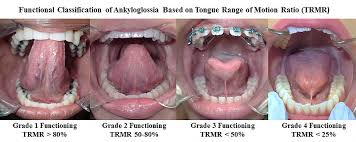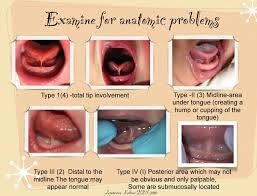Tongue & Lip Tie
What is a tongue & lip tie?
A tie is a band of tissue connecting one structure to another (tongue to floor of mouth or lip to the alveolar ridge) that restrict the movement or range of motion because it is too short, tight or long (as in the upper lip tie). We know the elevation of the tongue is more important than protrusion (sticking tongue out) of the tongue.
What are the signs & symptoms of ties?
In breast feeding infants symptoms can be: acting irritable or fussy during and after feeding, difficulty creating a secure latch during nursing, poor weight gain, weight loss, choking or gagging while feeding, reflux symptoms, upper lip curls under when nursing, milk leaking out the sides of their mouth during nursing, and / or short sleep episodes (feeding every 1-2 hours). For nursing mothers, a baby with a tie will cause breast pain, plugged milk ducts, engorgement, cracked or blistered nipples, baby chewing or chopping on breast and / or nipple infections.
In children, teens and adults symptoms can be: difficulty with speech, eating issues, sleep related issues, TM joint problems, headaches, excessive gage reflex, mouth breather, and / or crooked teeth.
What problems are associated with tongue & lip ties?
Because of the breastfeeding struggles, ties can cause challenges; an increase risk of a failure to thrive diagnosis, low weight gain, decrease milk productions, acid reflux, pain or a stoppage of breastfeed. In order children, they can develop trouble chewing solid foods, develop a lisp or have speech problems, and developer a narrow upper palate which can lead to airway related problems and crooked teeth. Many adults who experience sleep related breathing disorders or TM joint pain, all have tongues which are tied. If they were treated at an early age, their conditions may not have developed.
Why should tongue & tie tied be fixed?
Because tongue ties are the root cause of so many frustrating secondary symptoms, the befits of frenectomies (tie release) are numerous:
Benefits of Frenectomies
- Improves breastfeeding
- Improves bottle feeding
- Prevents facial tooth decay
- Improves lip competences for correct breathing techniques.
- Prevents space between front teeth
- Helps with eating difficulties: eating with a spoon or drinking with a straw
- Reduces sinus infections
- Stimulates correct swallowing pattern
- Allows for proper forward growth of mandible
- Shapes the maxilla > widening the arch
- Shapes the floor of the nose > thereby opens airways
- Prevents future sleep breathing disorder
- Prevents digestive problems
- Allows for proper speech
- Speech improvements; especially certain letter: K,G,F,T,D,N,S,Z,Th, B, V,M and PI
Why perform the frenectomy using a CO2 laser?
Due to frustration and inconsistent results with scissors and other hot lasers, we found the best option was the CO2 laser. The lightScalpel CO2 laser allows for enhanced precision with pin-point accuracy and excellent results. It is the gold standard for infant frenectomies. We would never think to use anything different. The CO2 laser allows for no or minimal bleeding at the treatment site (very crucial for visualization of posterior ties and performing lip ties), shortened procedural times (a little as 10-15 seconds per site), with minimal pain and swelling but faster recovery and healing time.
What is the difference between a frenotomy and a frenectomy?
A frenotomy is a clipping or snipping of a tie with a pair of scissors causing the site to bleed. Whereas a frenectomy is a precise procedure using a laser with a pin-point accuracy to completely eliminate the tissues restricting the tie.
Will a tongue / lip tie grow back?
In most cases, no. Post-operative care and follow-up visit to extended team members is crucial for success. Do your stretches-quality is better than quantity. Visit the extended team members; locations consultants, midwives chiropractors, speech therapist and massage therapist. Practice your myofunctional activities. Our dedicated clinicians will give you information on all follow-up care. 90% of toddles get some reattachment > need to do deep stretches.
Help you child eat, sleep and speak better!

